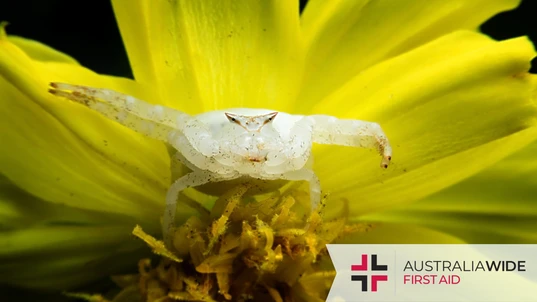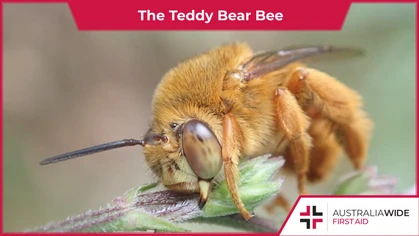Australian Crab Spiders: Nature's Masters of Camouflage

Bites and Stings

Renowned for its visually striking features, the Australian crab spider can be found in a variety of habitats, including urban areas. They have been known to bite when threatened, and their venom can cause pain, redness, and even dizziness.
The Australian Crab Spider (Thomisus Spectabilis) is an intriguing and visually striking species of spider that has captured the attention of both scientists and nature enthusiasts alike. Known for its distinctive physical characteristics, this spider belongs to the family Thomisidae, which is a diverse group of spiders commonly referred to as crab spiders. The name "crab spider" is derived from its appearance, which bears a striking resemblance to crabs due to their flattened bodies and wide, angled legs. Found in a variety of habitats across Australia and parts of Asia, the Australian Crab Spider is widely recognised for its remarkable hunting skills, unique behaviours, and impressive adaptations. With its diverse range of colours and fascinating traits, it truly is a remarkable creature that has captured the imagination of scientists and nature enthusiasts alike.Diverse Habitation
Common throughout much of southern and eastern Australia, the Australian Crab Spider is a versatile species that can adapt to a range of different habitats such as forests, woodlands, gardens, and even in urban areas, where they can find ample food sources. They are particularly well-suited to living in gardens and other areas with a lot of vegetation, as this provides them with plenty of places to hide and ambush their prey. One of the most common places to find Australian Crab Spiders is on flowers, giving rise to their nickname “flower spiders”. They often wait on the petals or inside the flowers themselves, where they can blend in and wait for their prey to come to them.A Kaleidoscope of Colours
The unique physical characteristics of the Australian Crab Spider make them a fascinating species to observe. Their flattened bodies and wide, angled pairs of legs give them a distinctive crab-like appearance that allows them to blend in seamlessly with their surroundings. This physical adaptation allows them to remain hidden from both predators and prey, making them an effective ambush predator. The Australian Crab Spider's coloration can vary greatly depending on their surroundings. This is due to their ability to change colour in order to blend in with their environment. They are able to do this by using special pigments in their skin that can adjust to match the colours around them. This ability to camouflage themselves makes them difficult to spot, even for keen-eyed predators. In addition to their unique body shape and coloration, the Australian Crab Spider also has long, thin legs that can extend outwards in a crab-like fashion. Male Australian crab spiders are usually smaller than females with an average body length of 5-6mm, whilst females can grow 8-10mm in length. Female crab spiders also have a rounder abdomen, which is essential for carrying their egg sacs. Interestingly, Australian crab spiders do not have claw tufts and so cannot climb across smooth surfaces.Ambush Predator
The Australian Crab Spider is an ambush predator that relies on speed and agility to catch its prey. They do not build webs like many other species of spiders, instead relying on their camouflage and hunting skills to capture their prey. The Australian Crab Spider has excellent vision and can detect movement from a distance, which allows them to spot potential prey and predators quickly. These spiders hide on flowers or other vegetation, patiently waiting for their prey to come to them. When the opportunity arises, they will pounce on their prey with lightning-fast speed, using their front legs to grasp and immobilise their target. Once their prey is captured, they will inject venom to immobilise it before consuming it. The Australian Crab Spider is a solitary species that prefers to hunt and live alone. Overall, their behaviour is focused on hunting and survival, making them a fascinating species to observe in the wild.The Venom of the Australian Crab Spider: Risks and Treatment
While the Australian Crab Spider is not considered dangerous to humans, they can still bite if they feel threatened. Its venom is not potent enough to cause serious harm, however, it can cause local pain, swelling, and redness. Some individuals may also experience nausea, headache, and dizziness as a result of the bite. It’s important to take first aid measures if you are bitten. The first step is to clean the area thoroughly with soap and water to reduce the risk of infection. It is essential to try to identify the spider that bit you, as this can help medical professionals determine the appropriate treatment if necessary. After cleaning the bite area, a cold compress can be applied to help reduce swelling and pain. This can be done by wrapping ice or a cold pack in a towel and applying it to the affected area for 10-15 minutes at a time. Over-the-counter pain relievers such as ibuprofen or acetaminophen can also be taken to alleviate discomfort and reduce swelling. If symptoms persist or worsen, seek medical attention immediately. In some cases, antihistamines or other medications may be necessary to treat an allergic reaction. To learn more about general first aid courses check out the following links:Final Thoughts
The Australian Crab Spider is truly an amazing species of spider that has captured the hearts of many scientists and nature enthusiasts. Its unique physical characteristics, including its flat body, angled legs, and ability to change colour, allow it to blend in with its environment and become a stealthy predator. Even though the venom of the Australian Crab Spider is not harmful to humans, it is still necessary to follow proper first aid measures when bitten, including cleaning the bite area, and monitoring for signs of infection or allergic reaction. This spider's ability to adapt to different habitats, combined with its impressive hunting skills, makes it a fascinating creature that adds to the incredible diversity of our natural world. Studying and understanding the Australian Crab Spider helps us to appreciate the complexity and beauty of the animal kingdom and reminds us of the importance of preserving and protecting the delicate ecosystems in which they thrive.
Originally published at
https://www.australiawidefirstaid.com.au/resources/australian-crab-spider
as part of the Australia Wide First Aid Articles Library









